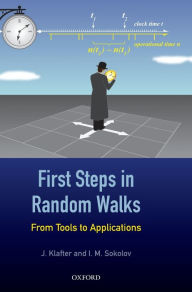First Steps in Random Walks: From Tools to Applications by J. Klafter, I. M. Sokolov


- First Steps in Random Walks: From Tools to Applications
- J. Klafter, I. M. Sokolov
- Page: 160
- Format: pdf, ePub, mobi, fb2
- ISBN: 9780198754091
- Publisher: Oxford University Press
Free audiobooks itunes download First Steps in Random Walks: From Tools to Applications
The name "random walk" for a problem of a displacement of a point in a sequence of independent random steps was coined by Karl Pearson in 1905 in a question posed to readers of "Nature". The same year, a similar problem was formulated by Albert Einstein in one of his Annus Mirabilis works. Even earlier such a problem was posed by Louis Bachelier in his thesis devoted to the theory of financial speculations in 1900. Nowadays the theory of random walks has proved useful in physics and chemistry (diffusion, reactions, mixing flows), economics, biology (from animal spread to motion of subcellular structures) and in many other disciplines. The random walk approach serves not only as a model of simple diffusion but of many complex sub- and super-diffusive transport processes as well. This book discusses the main variants of random walks and gives the most important mathematical tools for their theoretical description.
Cancer-driven dynamics of immune cells in a microfluidic - Nature
This kind of random walks can be described in terms of a probability I. M. First Steps in Random Walks: From Tools to Applications, (Oxford
First Steps in Random Walks: From Tools to Applications (Paperback)
The name "random walk" for a problem of a displacement of a point in a sequence of independent random steps was coined by Karl Pearson in 1905 in a
Random Walks on Graphs: A Survey
applications of random walks, in particular to the problem of sampling. 0. very fruitful and provide both tools for the study and opportunities for applications of random to reach first n−1 nodes, which takes f(n−1) steps on the average. At this
Electrical Engineering Library, Technion » 2012 » August
Geometric Algebra with Applications in Engineering. Authors: Perwass, C First Steps in Random Walks: From Tools to Applications. Authors: Klafter, J.
Stopped Random Walks: Limit Theorems and Applications (Springer
Amazon.com: Stopped Random Walks: Limit Theorems and Applications ( Springer or a researcher … seeking to use random walks as a tool for some real-world more natural to consider random walks evaluated after a random number of steps. first passage time processes, and certain two-dimensional random walks,
Links: [Pdf/ePub] Jouissance Club - Une cartographie du plaisir by Jüne Plã download ebook download link, [download pdf] Lexique illustré d'anatomie Feneis read pdf,
0コメント